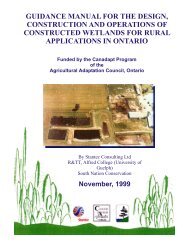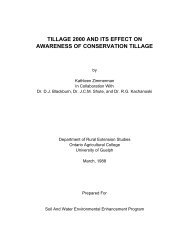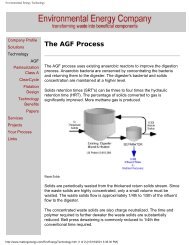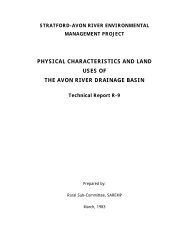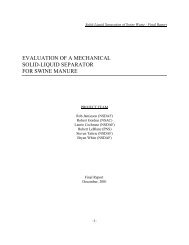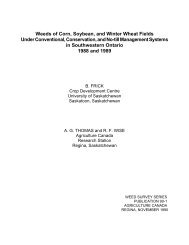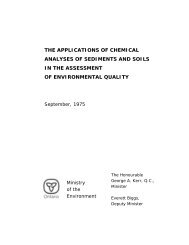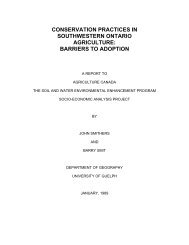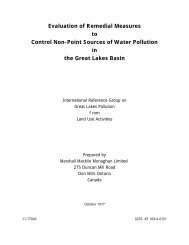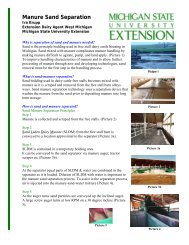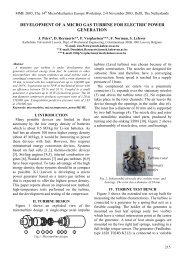Environmental Aspects of Phosphate and Potash Mining United ...
Environmental Aspects of Phosphate and Potash Mining United ...
Environmental Aspects of Phosphate and Potash Mining United ...
You also want an ePaper? Increase the reach of your titles
YUMPU automatically turns print PDFs into web optimized ePapers that Google loves.
Emerging <strong>Environmental</strong> Issues <strong>and</strong> Trends<br />
50<br />
<br />
<br />
<br />
<br />
<br />
Monitoring <strong>and</strong> incident reporting;<br />
Corporate environmental reporting;<br />
Integrated pollution prevention <strong>and</strong> control;<br />
Voluntary initiatives;<br />
Cleaner production.<br />
This publication draws attention to the importance <strong>of</strong><br />
preventative, rather than remedial action in order to<br />
reduce the potentially environmental impacts <strong>of</strong> company<br />
activities. The publication also argues that a<br />
comprehensive environmental management system<br />
can be <strong>of</strong> intrinsic value to the company. New<br />
approaches are likely to be developed in the future.<br />
The present publication has explored a variety <strong>of</strong><br />
approaches <strong>and</strong> techniques being used by the fertilizer<br />
raw material mining industry in response to environmental<br />
issues. In many instances, new technologies<br />
<strong>and</strong> practices have been developed or applied to<br />
resolve specific problems. In others, the implementation<br />
<strong>of</strong> new management systems has improved<br />
environmental performance - in many cases with economic<br />
benefit - through a better underst<strong>and</strong>ing <strong>of</strong> the<br />
environmental causes <strong>and</strong> effects.<br />
Companies are starting to perceive marketing <strong>and</strong><br />
even economic advantages from the implementation<br />
<strong>of</strong> such systems. This trend is expected to continue as<br />
consumer awareness <strong>and</strong> dem<strong>and</strong>s for improved<br />
industry performance grow <strong>and</strong> government legislation<br />
evolve to reflect this. Markets are becoming more<br />
discriminating; environmental <strong>and</strong> “ethical” investment<br />
funds have been established; <strong>and</strong> some financial<br />
institutions are beginning to examine a company's<br />
environmental performance when making loan<br />
assessments.<br />
Many complex issues face the mining industry <strong>and</strong><br />
these are best tackled using a multidisciplinary<br />
approach. Achieving a balance between the environmental,<br />
economic, <strong>and</strong> social needs <strong>of</strong> society is<br />
important if development is to be sustainable. This is<br />
most effective when a long-term perspective is adopted.<br />
The life-cycle approach used to structure this<br />
publication demonstrates one method <strong>of</strong> examining<br />
the impact <strong>of</strong> companies' activities <strong>and</strong> products as a<br />
whole. A variety <strong>of</strong> strategies <strong>and</strong> tools, such as cleaner<br />
production, life cycle analysis <strong>and</strong> industrial<br />
ecology have been developed to assist management for<br />
this purpose.<br />
The mining life-cycle approach highlights the importance<br />
<strong>of</strong> planning, environmental management <strong>and</strong><br />
rehabilitation from the outset <strong>and</strong> throughout the life<br />
<strong>of</strong> the mine. This fosters a preventative approach,<br />
allowing:<br />
Identification <strong>of</strong> potentially adverse environmental<br />
effects;<br />
Implementation <strong>of</strong> plans, systems, procedures <strong>and</strong><br />
practices to avoid or mitigate potentially adverse<br />
impact;<br />
Detection <strong>of</strong> variance from plans by monitoring<br />
environmental performance.<br />
Communication <strong>and</strong> dissemination <strong>of</strong> information<br />
within <strong>and</strong> between companies through means such<br />
as newsletters, workshops <strong>and</strong> conferences are important<br />
to continually improve environmental<br />
performance.<br />
A particular characteristic <strong>of</strong> the mining industry is<br />
the need to anticipate when the economic ore reserve<br />
will be depleted <strong>and</strong> the operation will close. The site<br />
must be left in a safe <strong>and</strong> stable form, allowing it to be<br />
returned to the pool <strong>of</strong> l<strong>and</strong> available for society. The<br />
closure <strong>and</strong> rehabilitation <strong>of</strong> sites needs to be planned<br />
from the outset, not left for future generations. Many<br />
governments now require, or are examining, financial<br />
provisions for mine closure to be set aside by companies<br />
during its operations to avoid environmental<br />
liabilities being h<strong>and</strong>ed over to the community.<br />
How can industry associations facilitate improved<br />
performance Encouragement <strong>and</strong> support from<br />
industry associations <strong>and</strong> companies can assist the fertilizer<br />
mining industry in its response to future<br />
challenges.<br />
They can:<br />
Provide leadership;<br />
Assemble <strong>and</strong> communicate information on good<br />
practices, new developments <strong>and</strong> trends that may<br />
affect the industry, through means such as conferences,<br />
workshops, <strong>and</strong> publications;<br />
Develop guidelines on good practices;<br />
Encourage the adoption <strong>of</strong> voluntary codes to foster<br />
continued improvement.



